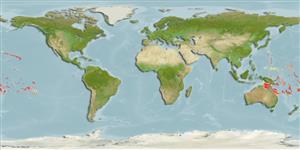Teleostei (teleosts) >
Acanthuriformes (Surgeonfishes) >
Chaetodontidae (Butterflyfishes)
Etymology: Hemitaurichthys: Greek, hemi = half + Greek, taureia = skin of bull + Greek, ichthys = fish (Ref. 45335).
Eponymy: John W Thompson was an artist and modeller at the Bishop Museum, Honolulu (1901– 1928). [...] (Ref. 128868), visit book page.
More on author: Fowler.
Environment: milieu / climate zone / depth range / distribution range
Ecology
Marine; reef-associated; depth range 4 - 300 m (Ref. 1602). Tropical; 31°N - 24°S, 136°E - 130°W
Pacific Ocean: Mariana, Samoa, Johnston, Hawaiian, Line (Ref. 9710), and Tuamoto islands.
Size / Weight / Age
Maturity: Lm ? range ? - ? cm
Max length : 18.0 cm TL male/unsexed; (Ref. 9710)
Found in coral reefs (Ref. 43239). Occur in schools above steep outer reef slopes at depths below 10 m to 300 m and sometimes above clear lagoon reefs at depths as shallow as 4 m. Uncommon (Ref. 9710). Benthopelagic (Ref. 58302). Feeds on zooplanktons (Ref. 89972). Oviparous (Ref. 205). Form pairs during breeding (Ref. 205).
Life cycle and mating behavior
Maturity | Reproduction | Spawning | Eggs | Fecundity | Larvae
Form pairs during breeding (Ref. 205).
Myers, R.F., 1991. Micronesian reef fishes. Second Ed. Coral Graphics, Barrigada, Guam. 298 p. (Ref. 1602)
IUCN Red List Status (Ref. 130435: Version 2024-2)
Threat to humans
Harmless
Human uses
Fisheries: commercial; aquarium: commercial
Tools
Special reports
Download XML
Internet sources
Estimates based on models
Preferred temperature (Ref.
123201): 21.8 - 28.9, mean 25.6 °C (based on 39 cells).
Phylogenetic diversity index (Ref.
82804): PD
50 = 0.5625 [Uniqueness, from 0.5 = low to 2.0 = high].
Bayesian length-weight: a=0.02239 (0.01097 - 0.04568), b=3.01 (2.84 - 3.18), in cm total length, based on LWR estimates for this (Sub)family-body shape (Ref.
93245).
Trophic level (Ref.
69278): 3.0 ±0.0 se; based on diet studies.
Resilience (Ref.
120179): High, minimum population doubling time less than 15 months (Preliminary K or Fecundity.).
Fishing Vulnerability (Ref.
59153): Low vulnerability (10 of 100).
Nutrients (Ref.
124155): Calcium = 87.2 [44.4, 138.7] mg/100g; Iron = 0.912 [0.530, 1.555] mg/100g; Protein = 18.2 [16.9, 19.5] %; Omega3 = 0.138 [0.078, 0.246] g/100g; Selenium = 50.6 [24.4, 103.6] μg/100g; VitaminA = 67.6 [17.7, 252.5] μg/100g; Zinc = 1.29 [0.84, 1.86] mg/100g (wet weight);
